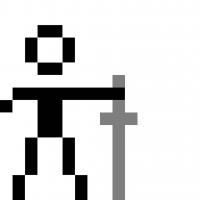I prefer something in between, not fully dynamic difficulty, but not "difficulty settings" either. (I think both are easy to miscalibrate, and have the potential to insult the player when miscalibrated.) What I like best is adaptive difficulty as a result of in-game player choices, where the consequences of that choice are clear to the player. Particularly when difficulty is encapsulated in a conceptual metaphor that doesn't itself have a value label. For example:
Difficulty as a place: This is definitely the most common conceptual metaphor for difficulty in games, where easy and hard difficulties are encapsulated as easy and hard places, and choosing the difficulty therefore uses the metaphor of traveling. That's a natural human metaphor; accomplishing things in the actual world is easy and hard depending on location. If you want an easy game, you can stick to easy "places", if you want a hard game, you can stick to hard "places".
This doesn't necessarily mean making more levels; you could have same or similar levels be duplicated with different difficulties, just represented as different places. For example, even if you're intending to have a linear game with levels 1, 2, 3, etc., you could implement this metaphor by giving them a grid-like map of levels to choose from where the horizontal axis is the level and the vertical axis is the difficulty. Traveling "east" gives you new content, traveling "north" gives you the same content adapted for greater difficulty.
I'm planning this for a game of mine that I need to expand to have more "levels" to challenge more-skilled players. I'm not going to label the difficulties, in part because players are proving to have really strikingly different natural aptitudes for the in-game task; I don't feel like telling the player that what they find "difficult" is what other players find "easy". Rather, the level map will represent the difficulty of the level -- which corresponds to the availability of resources -- by representing harder levels as more arid, sparse, or harsh. Players can spend as much time as they want having lower-challenge fun in the more lush areas, and venture out into the more-difficult outback whenever, and to whatever distance, they feel like.)
Difficulty as an item: You can also have things that you carry, or abilities that you can turn on and off, that either make the game harder for a greater reward or easier for a lesser reward. (For example, Bastion had the shrines, or whatever they were, where you could make enemies harder but drop more rewards.)
Difficulty as a consequence: There's some kind of action you can perform in-game that changes the world to become easier or harder. (For example, in Dishonored you always have a choice between lethal and non-lethal takedowns, and things become more difficult the more people you kill. In... I think it was Shovel Knight, you can go around destroying autosave checkpoints.)
Actually, there are two other things to consider, rather than going for dynamic difficulty. The reason so many games of almost every genre now have EXP mechanics is to mitigate exactly what you're concerned about (locking out less-skilled players from seeing content that you want them to see), by letting player pursue easier challenges as much as they want in order to make further challenges a bit easier.
The other is that lots of games for "casuals" are actually quite difficult, sometimes; it's just that they tend to make failure states as smooth as possible. That is, they make it easy to jump back in and don't shovel a lot of judgment on the player for failing.










